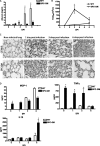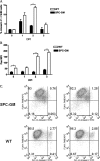GM-CSF in the lung protects against lethal influenza infection
- PMID: 21474645
- PMCID: PMC6938174
- DOI: 10.1164/rccm.201012-2036OC
GM-CSF in the lung protects against lethal influenza infection
Abstract
Rationale: Alveolar macrophages contribute to host defenses against influenza in animal models. Enhancing alveolar macrophage function may contribute to protection against influenza.
Objectives: To determine if increased expression of granulocyte/macrophage colony-stimulating factor (GM-CSF) in the lung increases resistance to influenza.
Methods: Wild-type mice and transgenic mice that expressed GM-CSF in the lung were infected with influenza virus, and lung pathology, weight loss, and mortality were measured. We also administered GM-CSF to the lungs of wild-type mice that were infected with influenza virus.
Measurements and main results: Wild-type mice all died after infection with different strains of influenza virus, but all transgenic mice expressing GM-CSF in the lungs survived. The latter also had greatly reduced weight loss and lung injury, and showed histologic evidence of a rapid host inflammatory response that controlled infection. The resistance of transgenic mice to influenza was abrogated by elimination of alveolar phagocytes, but not by depletion of T cells, B cells, or neutrophils. Transgenic mice had far more alveolar macrophages than did wild-type mice, and they were more resistant to influenza-induced apoptosis. Delivery of intranasal GM-CSF to wild-type mice also conferred resistance to influenza.
Conclusions: GM-CSF confers resistance to influenza by enhancing innate immune mechanisms that depend on alveolar macrophages. Pulmonary delivery of this cytokine has the potential to reduce the morbidity and mortality due to influenza virus.
Figures







Comment in
-
GM-CSF and influenza: will saving mice help humans?Am J Respir Crit Care Med. 2011 Jul 15;184(2):157-8. doi: 10.1164/rccm.201105-0833ED. Am J Respir Crit Care Med. 2011. PMID: 21765031 No abstract available.
References
-
- Coro ES, Chang WL, Baumgarth N. Type I IFN receptor signals directly stimulate local B cells early following influenza virus infection. J Immunol 2006;176:4343–4351. - PubMed
-
- Kuwano K, Braciale TJ, Ennis FA. Cytotoxic T lymphocytes recognize a cross-reactive epitope on the transmembrane region of influenza H1 and H2 hemagglutinins. Viral Immunol 1989;2:163–173. - PubMed
-
- Brown DM, Roman E, Swain SL. CD4 T cell responses to influenza infection. Semin Immunol 2004;16:171–177. - PubMed
Publication types
MeSH terms
Substances
Grants and funding
LinkOut - more resources
Full Text Sources
Other Literature Sources
Medical

